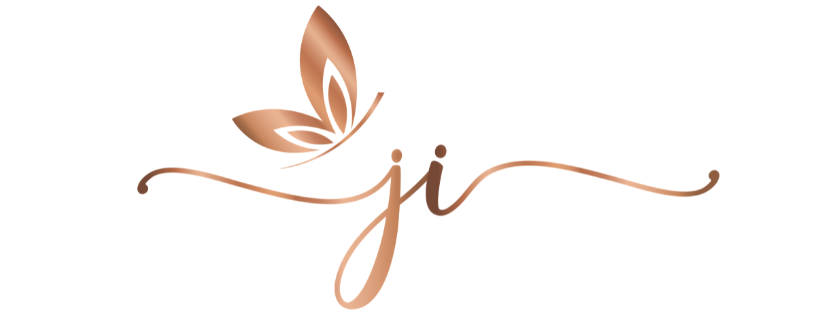Following our explorations at Ibn Tulun Mosque, we ventured over to the Gayer-Anderson Museum, which is conveniently located right next door. The museum is actually two houses, one built in 1540 and one in 1631, that were restored and connected with a bridge-room in the 1930s by an Englishman, Major Gayer-Anderson.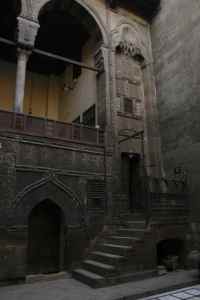
The rooms are beautifully decorated in Gayer-Anderson’s vast artwork, furniture and décor collections, and give an idea how the well-to-do Cairene might have lived during the 1930s.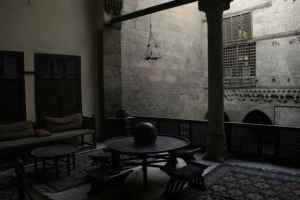
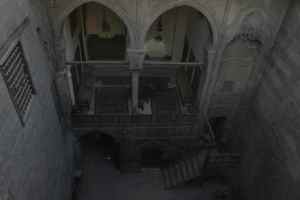
The roof of the connected houses is rimmed with mashrabiya screens, which, as you can see, were designed around a view of the Citadel. There were also scenes from James Bond’s “The Spy Who Loved Me” filmed on this roof, and in one of the interior rooms, so now we have to rent the movie again and watch more closely this time.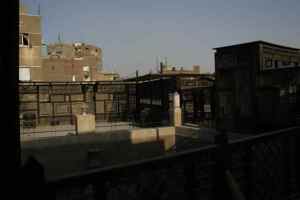
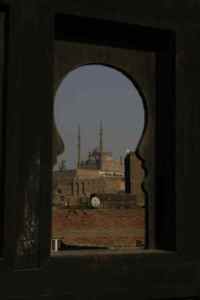
Following our force-guided tour (you “have” to have a guide, if merely to turn on the lights in the rooms as you walk through – having done it now twice, I can tell you that the same things/stories/jokes are told during each “tour” – slightly tedious, but compulsory), Haitham and I decided to do some walking. Now, when I say “some” walking, I need to preface this and add that Haitham’s idea of a nice walk is to go from Ibn Tulun Mosque in Islamic Cairo, to home. So that’s what we did. All in all, I think it was at least five miles, but it felt longer.
But this was the beginning of my foray into a whole new side of Cairo that, prior to Haitham’s guidance and accompaniment, I would not have ventured into. It’s not that it’s unsafe, but it’s inner inner Cairo, and I don’t recall seeing many (any?) other non-Egyptian-looking folk, or blondes from Ohio. Plus, English was not as readily available as in touristy areas, so I had to rely 100% on Haitham asking for directions, several times as it’s always best to double and triple-check.
It was really fascinating walking through these streets, through people’s daily lives (of course, no camera this day… but I definitely got photos on our next outing). I did have a few moments where I felt like the human sore thumb, but I have perfected the act of pretending that people aren’t staring at me, or on particularly egocentric days pretending they’re mistaking me for a movie star. Either way, I just keep walking.
We had decided to try to find a market to buy some spices and maybe some veg. I really wanted to take advantage of Haitham’s language skills to replenish my spices and get some new ones. So we had been directed to a local market that was around behind the As-Sayyida Zeinab Mosque. This is an interesting mosque, in that it’s built for a woman, Sayyida Zeinab, who was the granddaughter of the Prophet Mohammed and is also the patron saint of Cairo. Ironically, at least I thought so, women are only allowed in the mosque through a side entrance and no non-Muslims are allowed in.
The market was indeed behind the mosque, and there was no question this was a local market. Foreigners were definitely foreign. But again, I pretended I come there all the time, and followed Haitham closely at his heels. We walked past stands stacked with fragrant oranges, then walked through the grapes and apples, onto the cutlery and pots and pans stalls, then past the hanging unidentifiable carcasses with furry tails stall (I diligently checked out the pink plastic salt and pepper shakers opposite these as we passed), finally to come to the spices (we merely had to follow our nose).
I love these! The mounds of colorful, fragrant, inviting spices, stacked up in their individual barrels, waiting to be scooped up and weighed. We were very successful and replenished my cumin and curry supplies, then added cardamom and turmeric and tried some Yen-Soon (anise) tea. (And Haitham was kind enough to let me document our success using his camera and himself.)
From here we wandered back and passed some gargantuan cabbages. Haitham was interested in getting one, ideally smaller than a car tire, so we picked through a stack, found an acceptable one and then looked around for the stall owner. We were directed to an elderly woman perched in a plastic deck chair. Haitham carried the cabbage to her, and I stood back, watching the whole interaction: Haitham in suit jacket, surrounded by Roald Dahl cabbages, standing under a sea of slinky lingerie hanging from hangers over their heads (we had obviously found the one-stop shop for those buying cabbages and negligees). The woman never took her eyes off Haitham, even as he handed her the cabbage. She reached out and gently patted the cabbage, obviously assessing Haitham more so than the vegetable. Making her decision she told him the price (obviously not necessarily by weight, but rather weighty stare). We paid and exited the market.
We had decided to walk home from here, so we got our bearings and headed to Tahrir Square or downtown, then home. As we walked through the crowded streets, full of shops, people, cars, busses, taxis, and more people, we passed one of the women selling the Baladi bread on the sidewalk. Haitham bought us three pieces for dinner (1 EGP each = $.18). It was my first “street food” purchase and quite a thrill. Ron’s comment later was, “Did you make sure to get the ones that had fallen on the ground?” We assured him we got the ones with extra dust and schmutz.
